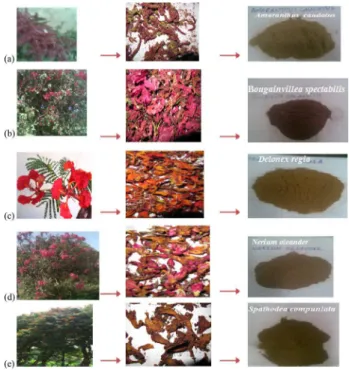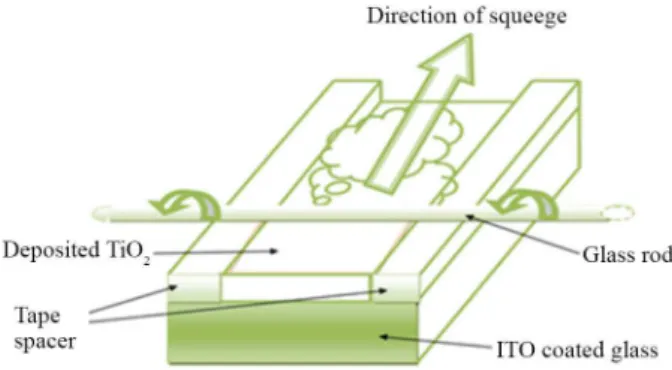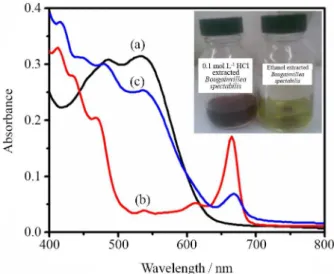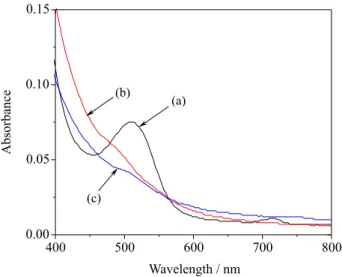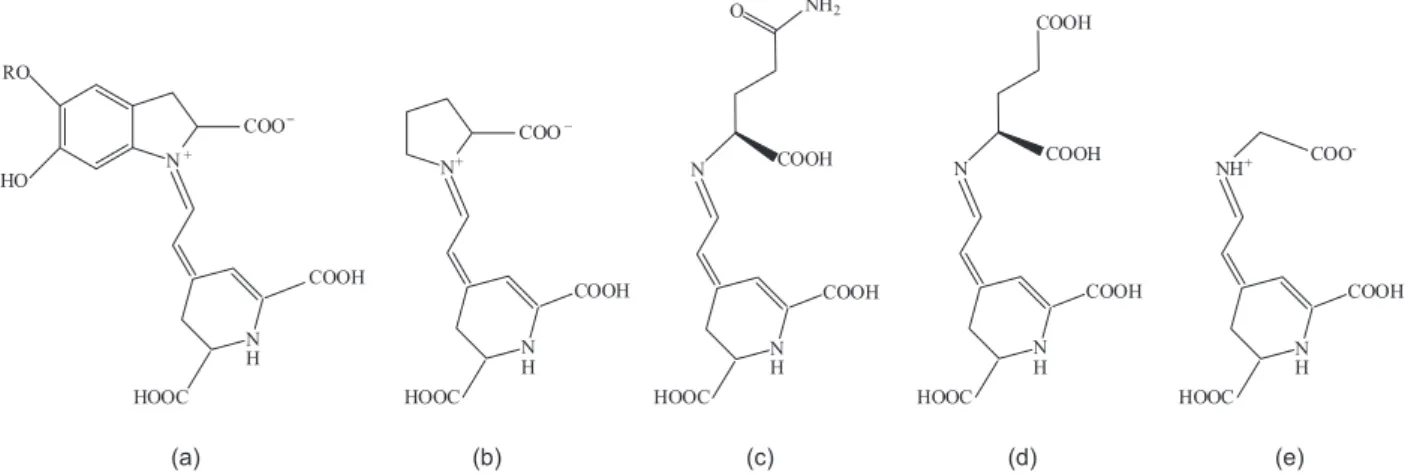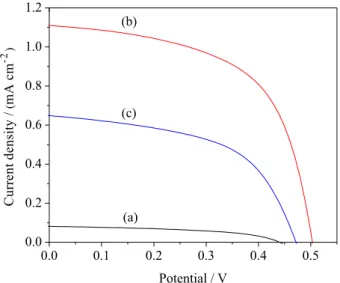Article
J. Braz. Chem. Soc., Vol. 26, No. 1, 92-101, 2015. Printed in Brazil - ©2015 Sociedade Brasileira de Química 0103 - 5053 $6.00+0.00
A
*e-mail: sisaytad@gmail.com
Dye Sensitized Solar Cells Using Natural Pigments from Five Plants and Quasi-Solid
State Electrolyte
Desalegn J. Godibo,a Sisay T. Anshebo*,b and Teketel Y. Ansheboc
aDepartment of Physics, College of Natural and Computational Sciences,
Arbaminch University, P.O.Box 21, Arbaminch, Ethiopia
bDepartment of Chemistry, College of Natural and Computational Sciences,
Hawassa University, P.O.Box 05, Hawassa, Ethiopia
cDepartment of Chemistry, College of Natural Sciences, Addis Ababa University,
P.O.Box 1176, Addis Ababa, Ethiopia
Células solares sensibilizadas por corantes (DSSCs) foram fabricadas usando corantes naturais extraídos das flores de Amaranthus caudatus, Bougainvillea spectabilis, Delonix regia, Nerium oleander, Spathodea companulata e uma mistura de extratos. O desempenho da célula fotoeletroquímica (PEC) DSSCs desses corantes mostrou um fator de preenchimento (FF) geralmente maior que 50%, a voltagem de circuito aberto (VOC) variou de 0,45 a 0,55 V, e as densidades de fotocorrente de circuito curto (JSC) ficaram na faixa de 0,013 a 1,82 mA cm
−2. A alta voltagem de circuito aberto (VOC = 0,55 V) e a densidade de fotocorrente de circuito curto (JSC = 1,82 mA cm−2) foram obtidas a partir de DSSC sensibilizada por extrato etanoico da flor de Amaranthus caudatus. A eficiência de conversão de energia (η) da DSSC com extrato etanoico da flor Amaranthus caudatus atingiu 0,61%. O desempenho da PEC DSSC com soluções de corantes misturados também foi investigado. No entanto, extratos misturados não apresentaram sinergia na fotosensibilização quando comparados aos extratos individuais. A célula sensibilizada somente pelo extrato etanoico da flor Amaranthus caudatus apresentou o melhor desempenho. Os dispositivos mostraram que a eficiência de conversão fóton-corrente monocromática incidente (IPCE) variou de 4,7% a 52%. Os resultados dos dados de IPCE são consistentes com as curvas J-V.
Dye-sensitized solar cells (DSSCs) were fabricated using natural dyes extracted from flowers of Amaranthus caudatus, Bougainvillea spectabilis, Delonix regia, Nerium oleander, Spathodea companulata and a mixture of the extracts. The photoelectrochemical cell (PEC) performance of the DSSCs of these dyes showed fill factors (FF) mostly higher than 50%, the open circuit voltages (VOC) varied from 0.45 to 0.55 V, and the short circuit photocurrent-densities (JSC) ranged from 0.013 to 1.82 mA cm−2. High open circuit voltage (VOC = 0.55 V) and short circuit photocurrent-density (JSC = 1.82 mA cm−2) were obtained from the DSSC sensitized by the ethanol extract of flower of Amaranthus caudatus. The power conversion efficiency (η) of the DSSC with the ethanol extract of Amaranthus caudatus flower reached 0.61%. The PEC performances of DSSCs of mixed dye solutions were also investigated. However, the mixed extract does not show any synergistic photosensitization compared to the individual extracts. Instead, the cell sensitized by the ethanol extract of Amaranthus caudatus flower alone showed the best performance. The devices showed incident monochromatic photon-to-current conversion efficiencies (IPCE) varied from 4.7% to 52%. The results from the IPCE data are consistent with the results from the (J-V) curves.
Introduction
The world’s energy consumption is continuously increasing and this creates a heavy demand for renewable energy sources to be developed. The largest challenge for our global society is to find ways to replace the slowly but inevitably vanishing fossil fuel supplies by renewable resources and, at the same time, avoid negative effects from the current energy system on climate, environment, and health. The worldwide power consumption is expected to double in the next three decades because of the increase in world population and the rising demand of energy in the
developing countries.1 This implies enhanced depletion of
easily utilizable fossil fuel reserves in near future, leading to further aggravation of the environmental pollution. The reserves of fossil and even nuclear fuel are also limited: for example, the constantly rising gas prices give indication of exhaustion of crude oil in the future. Solar energy is expected to play a crucial role as a future energy source. More solar energy strikes the earth in one hour
(4.3 × 1020 J h−1) than all the energy consumed on the earth
in a year (4.1 × 1020 J year−1).1 Solar energy provides clean
abundant energy and is therefore an excellent candidate for a future environmentally friendly energy source.
There are various types of solar cells that convert sun light into electrical energy. The commercially available solar cells are currently based on inorganic silicon semiconductors. The demand for silicon will skyrocket within the next decade and its price will rise dramatically. Organic solar cells, therefore, appear to be a highly promising and cost-effective alternative for the photovoltaic energy sector. In this context, dye-sensitized solar cells (DSSC) have attracted considerable attention
in recent years.2
The DSSC is a device for the conversion of visible light into electricity, based on the sensitization of wide
bandgap semiconductors.3 The performance of the cell
mainly depends on a dye used as sensitizer. The absorption spectrum of the dye and the anchorage of the dye to the
surface of TiO2 are important parameters determining
the efficiency of the cell.4 Generally, transition metal
coordination compounds (ruthenium polypyridyl complexes) are used as the effective sensitizers, due to their intense charge-transfer absorption in the whole visible range and highly efficient metal-to-ligand
charge transfer.5 However, ruthenium polypyridyl
complexes contain a heavy metal, which is undesirable
from point of view of the environmental aspects.6
Moreover, the process to synthesize the complexes is complicated and costly. Alternatively, natural dyes can be used for the same purpose with an acceptable
efficiency.4-11 The advantages of natural dyes include
their availability, environmental friendliness and
low cost.5
In this study we have extracted natural pigments from
five locally available flowers namely Amaranthus caudatus
(colour of the flower: deep red), Bougainvillea spectabilis
(colourof theflower: deepred), Delonix regia (colourof
the flower: red), Nerium oleander (colour of the flower:
rose) and Spathodea campanulata (colour of the flower:
red). We studied their photo-responses as sensitizers for dye-sensitized solar cells.
Experimental
Preparation of natural dye sensitizers
Enough amounts of the natural flowers namely
Amaranthus caudatus, Bougainvillea spectabilis,
Delonix regia, Nerium oleander and Spathodea campanulata
were collected. After collection, the plant materials were identified by a taxonomist and dried under shade area for 30 days and crushed to powder for extraction. Figure 1 shows the photographic picture of tree plants, the respective
drying flowers and the powder of Amaranthus caudatus,
Bougainvillea spectabilis, Delonix regia, Nerium oleander
and Spathodea campanulata.
A m a r a n t h u s c a u d a t u s p ow d e r o f 3 g a n d
Bougainvillea spectabilis powder of 3 g were separately
extracted in 200 mL of ethanol and 200 mL of 0.1 mol L−1
HCl, respectively, at room temperature. A mixed dye was prepared by mixing separately ethanol extracted
Amaranthus caudatus and Bougainvllea spectabilis solution
to 0.1 mol L−1 HCl extracted solution at a ratio of 1:1 by
volume, respectively. Similarly, 3 g of the powders of the last three plant materials were separately, extracted in
200 mL of 0.1 mol L−1 HCl at room temperature. The glass
containers were covered with aluminium foils to prevent damage from light exposure and were left to shake for one day. Thereafter the solid residues were filtered out to obtain clear dye solutions.
Preparation of TiO2 electrode
Indium tin oxide (ITO) conductive glass sheets (2.5 cm × 1.5 cm) were first cleaned with acetone (Aldrich), 2-propanol (Riedel-de Haen) and ethanol (Fluka) for 30 min in each step using ultrasonic bath.
Preparation of mesoporous titanium dioxide (TiO2)
paste was done with the method described elsewhere.12
The preparation of nanocrystalline films employed commercial titanium dioxide nanopowder (P25, Degussa AG, Germany, a mixture of about 30% rutile and 70% anatase). In order to break the aggregates into separate particles, the powder (3 g) was ground in a porcelain mortar with a small amount of water (1 mL) containing acetic acid (0.1 mL) to prevent reaggregation of the particles. After the powder had been dispersed by the high shear forces in the viscous paste, it was diluted by slow addition of water (4 mL) under continued grinding. Finally, a detergent (0.05 mL Triton X-100, Aldrich) was added to facilitate the spreading of the colloid on the substrate. The ITO was covered on two parallel edges
with adhesive tape to control the thickness of the TiO2
film and to provide non-coated areas for electrical contact. The colloid was applied to one of the free edges of the conducting glass and distributed with a glass rod sliding over the tape-covered edges as shown Figure 2. After air
drying, the electrode was fired for 30 min at 450 °C in a furnace (Carbolite Model ELF 11/14B).
Coating of the TiO2 surface with dye was carried out
by soaking the film for overnight in the dyes extracted. After completion of the dye adsorption, the electrode was withdrawn from the solution under a stream of dry air. It was stored in dry ethanol or immediately wetted with redox electrolyte solution for testing.
Preparation of counter electrode
The poly(3,4-ethylenedioxythiophene) (PEDOT) film
on ITO (UNAXIS Corporation, sheet resistance 30 Ωsq−1)
for the counter electrode was formed by electrochemical polymerization of 3,4-ethylenedioxythiophene (EDOT) (Aldrich), in a three electrode one-compartment electrochemical cell.
The electrochemical cell consisted of a pre-cleaned ITO-coated glass working electrode, platinum foil
counter electrode and quasi-Ag/AgCl reference electrode.
The solution used for the polymerization contained
0.2 mol L−1 EDOT and 0.1 mol L−1 (C
2H5)4NBF4 (Aldrich)
in acetonitrile (Sigma-Aldrich). The monomer was used as received. The polymerization was carried out potentiostatically at +1.8 V for 2 s. At this potential, the electrode surface becomes covered with blue-doped PEDOT film. The cell was then rinsed with acetonitrile and dried in air.
Preparation of electrolyte
The polymer gel electrolyte was prepared by
the following process;13 0.9 mol L−1 of
3-ethyl-2-methylImmidazolium iodide (EMIM-I) was added into acetonitrile (Aldrich) under stirring to form a homogeneous liquid electrolyte. In order to obtain a better
conductivity, 0.5 mol L−1 of sodium iodide (BDH) was
dissolved in the above homogeneous liquid electrolyte,
and then 0.12 mol L−1 iodine and 35% (m/m) of polyvinyl
pyrrolidone (PVP) (Aldrich) were added. Then, the resulting mixture was heated at 70-80 °C under vigorous stirring to dissolve the PVP polymer, followed by cooling down to room temperature to form a gel state electrolyte. Finally, the gel electrolyte was deposited in the form of
thin film on top of the dye coated TiO2 electrode. The
DSSC was completed by pressing against PEDOT-coated ITO glass counter electrode. The photoelectrochemical cell (PEC) was then mounted in a sample holder inside
a metal box with an area of 1 cm2 opening to allow light
from the source. All experiments were carried out at ambient temperature.
Assembling of the complete DSSCs
The photoelectrode and the counter electrode were overlappingly placed in a holder so that the titanium dioxide covered area of the photoelectrode was the only part of the photoelectrode that was in contact with the counter electrode. The non-titanium dioxide covered area of the photoelectrode and the non-overlapping edge of the counter electrode were attached to the measuring equipment by means of cords and crocodile clips.
Measurement
The absorption spectra of dye solutions were recorded using GENESYS 2PC UV-Vis spectrophotometer. The photoelectrochemical measurements of the cell were performed using a computer controlled CHI630A electrochemical analyzer. A 150-W Xenon lamp regulated by an Oriel power supply (Model 68830) was used to illuminate the PEC. A grating monochromator (model 77250) placed into the light path was used to select a wavelength between 300 and 800 nm. The measured photocurrent spectra were corrected for the spectral response of the lamp and the monochromator by normalization to the response of a calibrated silicon photodiode (Hamamatsu, model S1336-8BK) whose sensitivity spectrum was known. No correction was made for the reflection from the surface of the sample. The white light intensity was measured in the position of the sample
cell with Gigahertz-Optik X11 Optometer. The intensity of
the incident light was 100 mW cm−2.
Results and Discussion
Absorption spectra of natural dyes
We attempted to use 5 kinds of colorful natural dyes as sensitizers for DSSCs. Figure 3 and Figure 4 show the
UV-Vis absorption spectra for the ethanol, 0.1 mol L−1 HCl,
and mixed extracts of 0.1 mol L−1 HCl and ethanol solutions
of Amaranthus caudatus and Bougainvillea spectabilis,
respectively. Figure 3b and Figure 4b show that the
ethanol extracts of A m a ra n t h u s c a u d a t u s and
Bougainvillea spectabilis, whose colors are green, reach a maximum absorption peak of 665 nm and 413 nm. The main component of these two extracts is chlorophyll.
Figure 3a and Figure 4a also demonstrate the 0.1 mol L−1
HCl extracts of Amaranthus caudatus and Bougainvillea
spectabilis, whose colors are red. Amaranthus caudatus extract displayed an intense absorption in the 500-600 nm region, due
to the red-purple betacynines and Bougainvillea spctabilis
extract displayed an intense absorption in the 400-600 nm region due to the mixed contributions of the yellow-orange betaxanthins (480 nm) and of the red-purple betacyanines
(540 nm).14 Furthermore, the absorption peaks of mixed dyes
of Amaranthus caudatus extracts and Bougainvillea spctabilis
extracts are displayed in Figure 3c and Figure 4c. The absorption peaks of the mixed dyes are in the visible light range about 670 nm, and 536 nm for dyes mixed extract of Amaranthus caudatus and about 668 nm, 536 nm, 479 nm, 446 nm, and 416 nm for dyes mixed extract of
Bougainvillea spctabilis. The light absorption spectrum of the mixed extract contained peaks corresponding to the contributions from the individual extracts.
Figure 3. UV-Vis absorption spectra of dye solutions of: (a) 0.1 mol L−1 HCl extracted Amaranthus caudatus extract, (b) ethanol Amaranthus caudatus extract and (c) mixture of dyes extracted in 0.1 mol L−1 HCl and ethanol. Inset: extract of Amaranthus caudatus in 0.1 mol L−1 HCl and ethanol.
Figure 5 shows the UV-Vis absorption spectra of
Delonix regia, Nerium oleander and Spathodea companulata
in 0.1 mol L−1 HCl solution. From Figure 5a, it can be seen
that there is an absorption peak at about 516 nm for the
extract of Delonix regia. This absorption ascribes to their
identical components, namely, anthocyanins, a group of
natural phenolic compounds.15 Anthocyanin is the core
component of some natural dyes and is often found in the fruits, flowers, and leaves of plants. Because anthocyanin shows color in the range of visible light from red to blue,
it is predicted to become a highly efficient sensitizer for
wide band gap semiconductors.16 The Nerium oleander
and Spathodea companulata in 0.1 mol L−1 HCl solution
do not show obvious maximum absorption peaks in the visible light region as observed in Figure 5b and Figure 5c. This is because the anthocyanin extracted was dominantly found in the colorless quinonoidal form and do not absorb in the visible region. However, upon acidifying, it turned out to be colored since the equilibrium shifts to the highly conjugated flavylium cation form. Anthocyanin usually exists as equilibrium system between quinonoidal and flavylium cation form.
Photoelectrochemical properties of DSSCs sensitized with natural dyes
Photovoltaic tests of DSSCs using these natural dyes as sensitizers were performed by measuring the current density-voltage (J-V) curves under irradiation with white
light (100 mW cm−2). The performance of natural dyes as
sensitizers in DSSCs was evaluated by short circuit current
density (JSC), open circuit voltage (VOC), fill factor (FF), and
power conversion efficiency (η). The photoelectrochemical
parameters of the DSSCs sensitized with natural dyes are listed in Table 1. It presents the performance of the natural
pigments based DSSCs in this work in terms of JSC, VOC,
FF and η compared to those of the results found in the
literature.
Table 1. Photoelectrochemical parameters of the DSSCs sensitized by ethanol extracted natural dyes, 0.1 mol L−1 HCl extracted natural dyes and mixture of dyes extracted in 0.1 mol L−1 HCl and ethanol (dye mixed solution)
Natural dye JSC / (mA cm−2) VOC / V FF / % η / % Reference
Amaranthus caudatusa 1.82 0.55 61 0.610 This work
Amaranthus caudatusb 0.102 0.53 61 0.033
Amaranthus caudatusc 0.44 0.45 58 0.114
Bougainvillea spectabilisa 1.11 0.5 58.6 0.325
Bougainvillea spectabilisb 0.081 0.45 48.3 0.018
Bougainvillea spectabilisc 0.648 0.47 54 0.164
Delonix regiab 0.114 0.47 57.9 0.031
Nerium oleanderb 0.046 0.5 57.5 0.013
Spathodea companulatab 0.013 0.46 44 0.003
Begoniaa 0.63 0.537 72.2 0.240 17
Bauhinia treea 0.96 0.572 66 0.360
China loropetala 0.84 0.518 62.6 0.270
Tangerinea 0.74 0.592 63.1 0.280
Rhododendrona 1.61 0.585 60.9 0.570
Lithospermuma 0.14 0.337 58.5 0.030
Mangosteen pericarpa 2.69 0.686 63.3 1.170
Fructus lyciia 0.53 0.689 46.6 0.170
aEthanol extracted natural dye; b0.1 mol L−1 HCl extracted natural dye and cmixture of natural dyes extracted from ethanol and 0.1 mol L−1 HCl.
400 500 600 700 800
0.00 0.05 0.10 0.15
(c) (b)
Wavelength / nm
Absorbance
(a)
Figure 5. UV-Vis absorption spectra of dye solutions of: (a) Delonix regia, (b) Nerium oleander and (c) Spathodea companulata extracted with 0.1 mol L−1 HCl.
400 500 600 700 800
0.00 0.05 0.10 0.15
(c) (b)
Wavelength / nm
Absorbance
The typical current density-voltage (J-V) curves of the DSSCs using the sensitizers extracted from
Amaranthus caudatus, Bougainvillea spectabilis,
Delonix regia, Nerium oleander, and Spathodea companulata are shown in Figure 6, Figure 7 and Figure 8, respectively. As shown in Table 1, Figure 6, Figure 7 and Figure 8, the fill factors of these DSSCs are mostly higher
than 50%. The VOC varies from 0.45 to 0.55 V, and the JSC
ranges from 0.013 to 1.82 mA cm−2. Specifically, a high
VOC = 0.55 V and JSC = 1.82 mA cm
−2 were obtained from
the DSSC sensitized by the dye of Amaranthus caudatus
extracted with ethanol; the efficiency of the DSSC reached 0.61%. These data are significantly higher than those of the DSSCs sensitized by other natural dyes in this work and showed a comparable performance to the DSSCs prepared
from other natural dyes done by other groups (Table 1).17
This is due to a broader range of the light absorption of
the extract adsorbed on TiO2, and the higher interaction
between TiO2 and chlorophyll in the Amaranthus caudatus
extract leads to a better charge transfer. Moreover,
chlorophyll in the Amaranthus caudatus extract may have
the shortest distance between the dye skeleton and the point
connected to TiO2 surface compared to that of other extracts
in this work.18 This could facilitate an electron transfer from
chlorophyll in the Amaranthus caudatus extract to the TiO2
surface and could be accounted for a better performance of Amaranthus caudatus extract sensitization.18 Even
though ethanol extract of Bougainvillea spectabilis is also
chlorophyll, the photoelectrochemical performance of the DSSC from the ethanol extract is lower compared with
the respective ethanol extract of Amaranthus caudatus.
This is because the concentration of chlorophyll in
Bougainvillea spectabilis is higher than its concentration in
the ethanol extract of Amaranthus caudatus as it is evident
from the absorption measurement. The high concentration
of chlorophyll leads to dye aggregation on the TiO2 film,
which intern leads to concentration quenching resulting in lower photoelectrochemical performance in DSSC of
ethanol extract of Bougainvillea spectabilis. Chlorophyll
plays an important role in plant photosynthesis; the DSSCs using chlorophyll derivatives as sensitizers obtained a
relatively high conversion efficiency.19,20 This is because
there are available bonds between the dye and TiO2
molecules through which electrons can transport from
the excited dye molecules to the TiO2 film.21 This result
indicates that the interaction between the sensitizer and the
TiO2 film is significant in enhancing the power conversion
efficiency of DSSCs.
The photovoltaic properties of the DSSCs sensitized
by the dyes extracted from Amaranthus caudatus and
Bougainvillea spectabilis with various solvents were studied
by measuring current density-voltage (J-V) curves, and the corresponding photoelectrochemical parameters are listed in Table 1. As observed, the efficiencies of the DSSCs using
ethanol extracts and 0.1 mol L−1 HCl extracts as sensitizer
are 0.61% and 0.033% for Amaranthus caudatus and 0.325%
and 0.018% for Bougainvillea spectabilis, respectively. The
photoelectrochemical performances of DSSCs using the mixed dye solutions were also investigated. The efficiencies
of mixed dye solutions are 0.114% for Amaranthus caudatus
and 0.164% for Bougainvillea spectabilis, respectively. The
efficiency of DSSC using mixed dye solution as sensitizer is much lower than the sum of the efficiencies of the DSSCs
sensitized with ethanol extracts and 0.1 mol L−1 HCl extracts.
This result indicates that the mixed extract adsorbed on TiO2
does not show synergistic photosensitization compared with individual extracts, which is in accordance with the results
reported by Wongcharee et al..22 However, this is rather
different from the result reported by Kumara et al.,23 in which a
DSSC fabricated using chlorophyll and shisonin dyes showed synergistic effect of both dyes. We hypothesize two possible reasons for this phenomenon in which the mixed extract of
Amaranthus caudatus and Bougainvillea spectabilis did not show synergistic photosensitization. First, although the DSSC
sensitized with the mixed extracts of Amaranthus caudatus
and Bougainvillea spectabilis utilize the light of several spectral regions, the coadsorption suppresses electron injection possibly due to the increase in concentration quenching. Second, the strong steric hindrance of basic molecular structures for the main components of the extracts of Amaranthus caudatus and Bougainvillea spectabilis with various solvents prevents the dye molecules from effectively
arraying on the TiO2 film. Hence, this leads to a deficiency
of electron transfer from dye molecules to conduction band of TiO2.
Obviously, the efficiency of the cell sensitized by the ethanol extract was significantly higher than the one
sensitized by the 0.1 mol L−1 HCl extract for Bougainvillea
spectabilis and Amaranthus caudatus. This is due to the difference in the kinds of dyes extracted. The ethanol extracts in both cases is chlorophyll whereas the respective
0.1 mol L−1 HCl extracts are betalains. The other extracts
mainly contain anthocyanins in both the 0.1 mol L−1 HCl and
ethanol extracts. Anthocyanins are much soluble in ethanol
than 0.1 mol L−1 HCl, which makes better performance of
the ethanol extract. This is because of higher solubility of
anthocyanin in ethanol,24 which reduces the aggregation of
dye molecules. A good dispersion of dye molecules on the oxide surface could in fact improve the efficiency of the system.
The prevailing pigment coloration of Bougainvillea
red, due to the combination of two main dyes: betacyanin (red-purple) and betaxanthin (yellow-orange), whose
schematic structures are reported in Scheme 1.25 Both dyes
contain carboxylic functional groups that facilitate TiO2
surface binding.
The major component of the ethanol extract of
Amaranthus caudatus and Bougainvillea spectabilis is chlorophyll. Scheme 2a and 2b show these families of compounds.
As noticed, the efficiencies of the DSSCs using
0.1 mol L−1 HCl extracts as sensitizers are 0.03% for
Delonix regia, 0.013% for Nerium oleander and 0.003% for Spathodea companulata. In the case of Delonix regia, the dye component is anthocyanin. The DSSCs sensitized by natural dyes mainly composed of anthocyanin (extract of Delonix regia) in this work, did not offer high conversion efficiency. This is because anthocyanins have no carboxyl
functional groups to chemically bind with TiO2 and
facilitate electron injection from the LUMO of the dye to
the conduction band of TiO2. Instead of this, weak physical
adsorption by intermolecular forces between the hydroxyl
of the anthocyanin and TiO2 exists leading to a possibility
of desorption of the dye from TiO2.
The main component of the dye extracted from
flower of Delonix regia, Nerium oleander, and
Spathodea companulata is anthocyanins. The structure of these classes of compounds is as depicted in Scheme 3.
Incident monochromatic photon to current conversion efficiency
Incident photon to current-conversion efficiency (IPCE) is defined as
IPCE
) (
) (
) (
) ( 1240
2 2
− −
⋅ ⋅ =
mW cm P
nm
mA cm I
nm eV
in SC
λ (1)
Figure 9 shows the action spectra for the DSSC sensitized
with natural pigments extracted from Amaranthus caudatus.
In the wavelength range of 300-800 nm, the IPCE plot exhibits a maximum of 52% at 430 nm with ethanol
extract for Amaranthus caudatus pigment-sensitized solar
cell. Whereas the IPCE peaks of 0.1 mol L−1 HCl extract
and mixed dye extract for Amaranthus caudatus
pigment-sensitized solar cells shows maximum at 350 nm with 6.8%
N+
N COO
H RO
HO
COOH
HOOC
–
N+
N COO–
COOH
H HOOC
N
N COOH
H HOOC
NH2
O
COOH N
N COOH
H HOOC
COOH
COOH
NH+
N COOH
H HOOC
COO
-(a) (b) (c) (d) (e)
Scheme 1. Chemical structure of betacyanins, (a) R = β-D-glucose (betanin), R = H (betanidin) and betaxantins [(b) indicaxanthin; (c) vulgaxanthin I; (d) vulgaxanthin II; (e) portulaxanthin].
N N
N N
Mg
O
O O
O O H
H
R
Scheme 2. General structures of the chlorophyll dyes: (a) R = CH3, chlorophyll-a (b) R = CHO, chlorophyll-b.
O+
OGlu
OH OH
OH R1
R2
harvesting by bare TiO2 semiconductor.
26 However, the
action spectra at wavelengths 400-600 nm originates from
the dye molecules adsorbed on the TiO2 surface.
Figure 11 shows the action spectra for the DSSC sensitized with natural pigments extracted f r o m D e l o n i x r e g i a , N e r i u m o l e a n d e r a n d
Spathodea companulata. In the wavelength range of 300-800 nm, the IPCE plot exhibits a maximum of
5.1% at 340 nm for Delonix regia pigment-sensitized
solar cell and of 4.7% at 330 nm for Nerium oleander
pigment sensitized solar cell, which is the action spectral
response of the bare TiO2 semiconductor,26 but beyond
400 nm there is still action spectral response which is contributed by sensitization of extracts.
0.0 0.1 0.2 0.3 0.4 0.5
0.0 0.5 1.0 1.5 2.0 (c) (b) C u rr e n t d e n si ty / ( m A c m -2 )
Potential / V (a)
Figure 6. J-V curves for DSSCs sensitized by the extract of Amaranthus caudatus extracted from: (a) 0.1 mol L−1 HCl,(b)ethanol and (c) mixture of dyes extracted in 0.1 mol L−1 HCl and ethanol.
0.0 0.1 0.2 0.3 0.4 0.5
0.0 0.2 0.4 0.6 0.8 1.0 1.2 C u rr e n t d e n si ty / ( m A c m -2 )
Potential / V (a)
(c) (b)
Figure 7. J-V curves for DSSCs sensitized by the extract of Bougainvillea spectabilis extracted from: (a) 0.1 mol L−1 HCl, (b) ethanol and (c) mixture of dyes extracted in 0.1 mol L−1 HCl and ethanol.
0.0 0.1 0.2 0.3 0.4 0.5
0.000 0.025 0.050 0.075 0.100 (c) (b) C u rr en t d en si ty / (m A cm -2 )
Potential / V
(a)
Figure 8. J-V curves for DSSCs sensitized by: (a) the extract of Delonix regia, (b) the extract of Nerium oleander and (c) the extract of Spathodea companulata extracted from 0.1 mol L−1 HCl.
and at 320 nm with 43.5%, respectively. These peaks are
due to direct light harvesting by bare TiO2 semiconductor.26
However, the action spectra in the wavelengths 400-600 nm
originates from the dye molecules adsorbed on the TiO2
surface.
Figure 10 shows the action spectra for the DSSC sensitized with natural pigments extracted from
Bougainvillea spectabilis. In the wavelength range of 300-800 nm, the IPCE plot shows a maximum of 27.7% at 410 nm with ethanol extract pigment-sensitized solar cell.
The IPCE peaks of 0.1 mol L−1 HCl extract and a mixed
dye extract for Bougainvillea spctabilis pigment-sensitized
solar cells occur at 345 nm with 5.8% and at 330 nm with 16.7%, respectively. These peaks are due to direct light
300 400 500 600 700 800
0 10 20 30 40 50 60 (b) (c) IP C E / %
Wavelength / nm
(a)
400 500 600
0 2 4 I P C E / % Wavelength /nm (c) (a)
Figure 9. IPCE curves for DSSCs sensitized by the extract of Amaranthus caudatus extracted from: (a) 0.1 mol L−1 HCl, (b) ethanol and (c) mixture of dyes extracted in 0.1 mol L−1 HCl and ethanol. Inset represents the IPCE of curves (a) and (c) in the wavelength range from 400-600 nm.
0.0 0.1 0.2 0.3 0.4 0.5
0.0 0.5 1.0 1.5 2.0 (c) (b) C u rr e n t d e n si ty / ( m A c m -2 )
Potential / V (a)
0.0 0.1 0.2 0.3 0.4 0.5
0.0 0.2 0.4 0.6 0.8 1.0 1.2 C u rr e n t d e n si ty / ( m A c m -2 )
Potential / V (a)
(c) (b)
0.0 0.1 0.2 0.3 0.4 0.5
0.000 0.025 0.050 0.075 0.100 (c) (b) C u rr en t d en si ty / (m A cm -2 )
Potential / V (a)
300 400 500 600 700 800
0 10 20 30 40 50 60 (b) (c) IP C E / %
Wavelength / nm (a)
For Amaranthus caudatus,Bougainvillea spctabilis, and
Delonix regia pigment sensitized solar cells, the spectral response shows a blue-shift due to the electronic coupling
between dye and TiO2.The results from the IPCE data are
consistent with the results from the J-V curves. The IPCE of the DSSC depends on the incident light harvesting and
light scattering.27 The former is due to the surface area of
TiO2 and the amount of adsorbed dye, whereas the later is
related to the morphology of TiO2.
Table 2 presents the wavelength at maximum absorbance in the visible region of the dye solutions extracted from
0.1 mol L−1 HCl and ethanol and maximum IPCE% of the
dye sensitized solar cells of the respective plant materials studied in this work.
300 400 500 600 700 800
0 10 20 30
(c) (a)
(c) (b)
IP
C
E
/
%
Wavelength / nm (a)
400 600 800
0 2 4 6
IP
C
E
/
%
Wavelength / nm
Figure 10. IPCE curves for DSSCs sensitized by the extract of Bougainvillea spectabilis extracted from: (a) 0.1 mol L−1 HCl, (b) ethanol and (c) mixture of dyes extracted in 0.1 mol L−1 HCl and ethanol. Inset represents the IPCE of curves (a) and (c) in the wavelength range from 400-600 nm.
300 400 500 600 700 800
0 1 2 3 4 5
(c)
(b)
IP
C
E
/
%
Wavelength / nm (a)
Figure 11. IPCE curves for DSSCs sensitized by: (a) the extract of Delonix regia, (b) the extract of Nerium oleander, and (c) the extract of Spathodea companulata extracted from 0.1 mol L−1 HCl.
Table 2. Wavelength at maximum absorbance of the dye solutions in the visible region and maximum IPCE of the dye sensitized solar cells of the respective dyes
Natural dye Solvent Absorption spectra
λmax / nm
Photocurrent action spectra
λmax / nm IPCE / %
Delonix regia
Ethanol − − −
0.1 mol L−1 HCl 510 590 33.8
Spathodea companulata Ethanol − − −
0.1 mol L−1 HCl − 340 56
Nerium oleander Ethanol − − −
0.1 mol L−1 HCl − 330 4.7
Amaranthus caudatus Ethanol 433, 466, 618, 664 430 52
0.1 mol L−1 HCl 530 350 6.8
Bougainvillea spectabilis Ethanol 433, 469, 608, 664 410 27.7
0.1 mol L−1 HCl 485, 532 345 5.8
Conclusions
Dyes obtained from flowers of five different plants were used as sensitizers in DSSCs. The dyes extracted from these materials contained anthocyanins, betalains and chlorophyll. The photoelectrochemical performance
of the DSSCs based on these dyes showed a VOC
ranging from 0.45-0.55 V, and JSC was in the range of
0.013-1.82 mA cm−2. The DSSC sensitized by Amaranthus
caudatus pigment extracted with ethanol offered the highest conversion efficiency of 0.61% among the extracts. This is
due to the better charge transfer between the Amaranthus
caudatus dye molecule and the TiO2 surface, which is
related to a dye structure. The photoelectrochemical
performance for the extracts of Amaranthus caudatus and
300 400 500 600 700 800
0 10 20 30
(c) (a)
(c) (b)
IP
C
E
/
%
Wavelength / nm (a)
400 600 800 0
2 4 6
IP
C
E
/
%
Wavelength / nm
300 400 500 600 700 800
0 1 2 3 4 5
(c)
(b)
IP
C
E
/
%
Bougainvllea spectabilis with different solvents indicated that the extracting solvent has an effect on the efficiency of DSSCs. DSSC fabricated using ethanol extract shows
a higher efficiency than that of 0.1 mol L−1 HCl extract,
reported as 0.61% and 0.033%, respectively for Amaranthus
caudatus, where as it was 0.325% and 0.018%, respectively for Bougainvllea spectabilis. Therefore, the ethanol
extract of Amaranthus caudatus should be an alternative
chlorophyll source for DSSC preparation in geographical
regions that Amaranthus caudatus is widely available.
Overall, natural dyes as sensitizers of DSSCs are promising because of their environmental friendliness, low-cost of production and simple and energy-efficient manufacturing.
References
1. Lewis, N. S.; Science2007, 315, 798. 2. Gratzel, M.; Nature2001, 414, 338.
3. Gratzel, M.; J. Photochem. Photobiol., C 2003, 4, 145. 4. Tennakone, K.; Kumara, G. R. R. R. A.; Kumarasinghe,
A. R.; Sirimanne, P. M.; Wijayantha, K. G. U.; J. Photochem. Photobiol., A 1996, 94, 217.
5. Hao, S.; Wu, J.; Huang, Y.; Lin, J.; Sol. Energy2006, 80, 209. 6. Amao, Y.; Komori, T.; Biosens. Bioelectron.2004, 19, 843. 7. Polo, A. S.; Iha, N. Y.; Sol. Energy Mater. Sol. Cells2006, 90,
1936.
8. Garcia, C. G.; Polo, A. S.; Iha, N. Y.; J. Photochem. Photobiol.,A 2003, 160, 87.
9. Smestad, G. P.; Sol. Energy Mater. Sol. Cells1998,55, 157. 10. Kumara, G. R. A.; Kanebo, S.; Okuya, M.; Onwona-Agyeman, B.;
Konno, A.; Tennakone, K.; Sol. Energy Mater. Sol. Cells2006, 90, 1220.
11. Cherepy, N. J.; Smestad, G. P.; Gratzel, M.; Zang, J. Z.; J. Phys. Chem.B1997, 101, 9342.
12. Nazeeruddin, M. K.; Kay, A.; Rodicio, I.; Humphry-Baker, R.; Muller, E.; Liska, P.; Vlachopoulos, N.; Gratzel, M.; J. Am. Chem.Soc. 1993, 115, 6382.
13. Fan, L.; Kang, S.; Wu, J.; Hao, S.; Lan, Z.; Lin, J.; Energy Sources Part A2010, 32, 1559.
14. Calogero, G.; Di Marco, G.; Cazzanti, S.; Caramori, S.; Argazzi, R.; Di Carlo, A.; Bignozzi, C. A.; Inter. J. Mol. Sci. 2010, 11, 254.
15. Aqil, F.; Ahmad, I.; World J. Microbiol. Biotechnol. 2003, 19, 653.
16. Cherepy, J.; Smestad, G. P.; Grätzel, M.; Zhang, J. Z.; J. Phys. Chem.B1997, 101, 9342.
17. Zhou, H.; Wu, L.; Gao, Y.; Ma, T.; J. Photochem. Photobiol., A 2011, 219, 188.
18. Sayama, K.; Tsukagoshi, S.; Mori, T.; Hara, K.; Ohga, Y.; Shipou, A.; Abe, Y.; Suga, S.; Arakawa, H.; Sol. Energy Mater. Sol. Cells2003, 80, 47.
19. Kay, A.; Humphry-Baker, R.; Grätzel, M.; J. Phys. Chem.1994, 98, 952.
20. Kalyanasundaram, K.; Vlachopoulos, N.; Krishnan, V.; Monnier, A.; Grätzel, M.; J. Phys.Chem.1987, 91, 2342. 21. Hao, S.; Wu, J.; Huang, Y.; Lin, J.; Sol. Energy2006, 80, 209. 22. Wongcharee, K.; Meeyoo, V.; Chavadej, S.; Sol. Energy Mater.
Sol. Cells 2007, 91, 566.
23. Kumara, G. R. A.; Kanebo, S.; Okuya, M.; Onwona-Agyeman, B.; Konno, A.; Tennakone, K.; Sol. Energy Mater. Sol. Cells2006, 90, 1220.
24. Lapornik, B.; Prosek, M.; Wondra, A. G.; J. Food Eng.2005, 71, 214.
25. Tesoriere, L.; Allegra, M.; Butera, D.; Livrea, M. A.; Am. J. Clin. Nutr.2004, 80, 94.
26. Grätzel, M.; J. Photochem. Photobiol., A2004, 164, 3. 27. Wang, Z. S.; Kawauchi, H.; Kashime, T.; Arakawa, H.; Coord.
Chem. Rev.2004, 248, 1381.
Submitted: March 26, 2014
